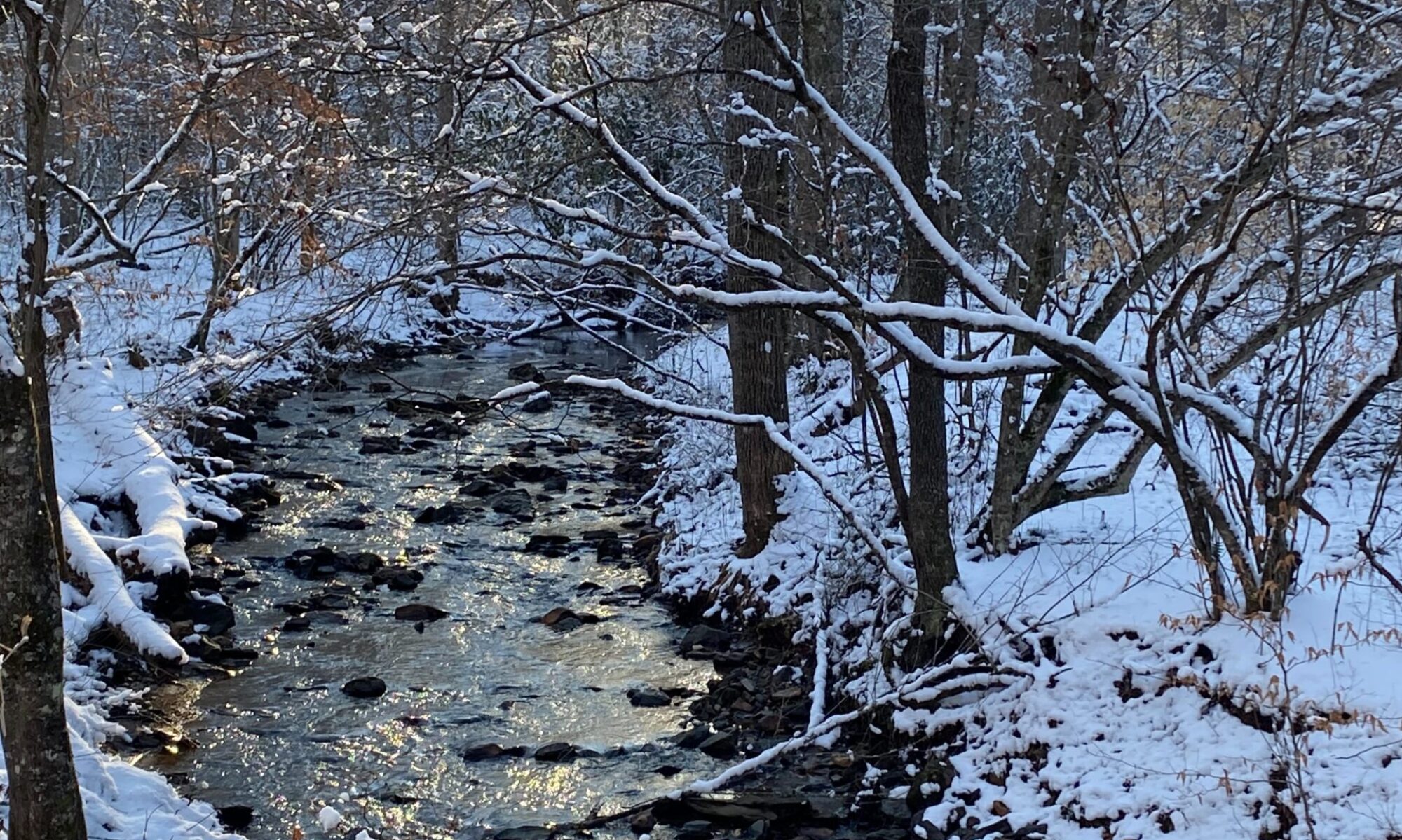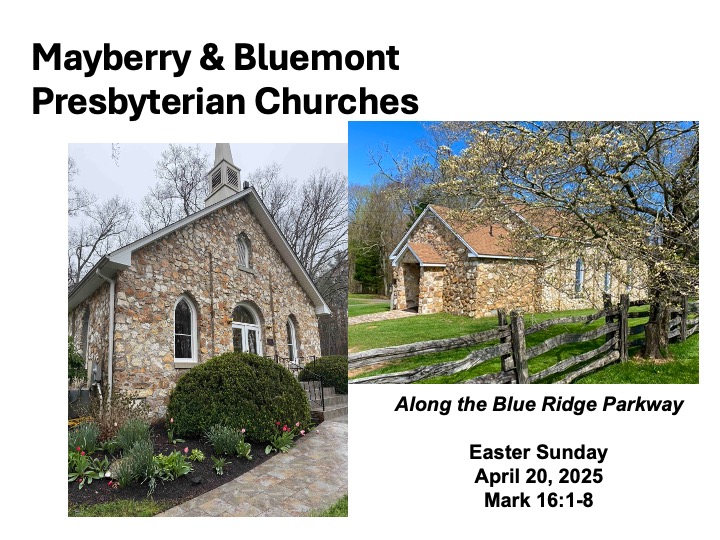Jeff Garrison
Mayberry and Bluemont Churches
Easter Sunday (April 20th) 2025
Mark 16:1-8
At the beginning of worship:
During the Kosovo War, a journalist filed a report about ethnic Albanian deportees in Macedonia. He described the rage experienced by Kosovan professors, writers, and other intellectuals who were robbed not only of their homes but also their books, papers, files—their irreplaceable life’s work. “Can such a deep hurt ever heal?” asked a reporter? Their editor, also an Albanian, then told them a story he’d heard as a child:
There was a naughty boy whose father would hammer a nail into a piece of wood every time his son would do something naughty. One day the boy asked why, and when it was explained, the boy decided he would behave better. Each time he did something good his father would remove a nail from the board. Eventually, all the nails came out…. Yes, the nails were gone,” he said. “But the holes always remained.”[1]
In John’s gospel we’re told Jesus’ wounds remained visible even after the resurrection. Thomas, when he heard Jesus was alive, questioned it and proclaimed that unless he felt the holes in his savior’s hands, he wouldn’t believe. And when Jesus next saw Thomas, he invited him to come forward and stick his finger in the holes of his hands and to place his hand in the side where the spear pierced. Thomas then not only believed, he became the first to declare Jesus to be God.[2]
The resurrected Jesus still had his wounds. So will we, who are wounded in this life. But our wounds will become beautiful. They’re signs of what Paul refers to when he says, “we’ve fought the good fight, finished the race, and kept the faith.”[3] On Easter, let’s remember and celebrate Jesus Christ, the one who leads the way. He’s the one we’re to follow, and who gives us hope for the life and the world to come.
Before reading the Scripture
Today, we’re completing our time in the gospel of Mark by looking at the original ending of the book. Mark ends at Mark 16:8. Mark’s original ending leaves the reader hanging, wondering what happened. It has been well documented that verses 9 to 20 were added much later than the rest of the book.[4]
Throughout the book, Mark focuses on the life of Jesus and that’s true even at the end. Matthew ends with the resurrected Christ giving the commission to the disciples to go out and establish the church. Luke carries on through Acts, showing the early growth of the church. As John’s gospel nears the ends, Jesus insists that Peter tend Jesus’ sheep.[5] In other words, Peter is to take care of those in the church.
Mark, on the other hand, primarily focuses on Jesus, his life and death. I think Mark assumes his audience knows Jesus’ the church has been established. What Mark emphasizes throughout the book is that Jesus is God and, when he comes to the Garden of Gethsemane as we saw last week, also human. While Mark has no nativity story like Matthew and Luke, we do learn the truth of the incarnation. In the life of Jesus, God becomes a man.
Mark provides less details of Jesus’ resurrection than the other gospels. We don’t hear of Jesus appearing to Mary, at least not right away.[6] There’s no race between Peter and John to the tomb.[7] Nor are their guards placed at the door of the tomb to make sure no one takes Jesus’ body.[8] Instead, Mark just gives the bare details and leaves it up to us to interpret. Let’s hear.
Read Mark 16:1-8
Our reading begins after the Sabbath. Jesus’ placement into the tomb came as the sun approached the horizon. Once the sun had set, the Sabbath began. The Hebrew calendar begins with the setting of the sun, not the rising. If any of you have seen Fiddler on the Roof, you’ll remember this. For the period after the sunset through the sunset, nothing that wasn’t necessary was to be done. It was a time of rest and meditation.
When the sun set the next evening, the Sabbath was over. We can imagine at this point; the two Marys and Salome went out as markets opened and purchasing the necessary spices to anoint Jesus body.
Then, as it was already dark, they wait until the next morning. With the sun having risen, they head to the tomb. Mark makes it obvious, these women assumed Jesus was going to be in the tomb and in need of the perfume as his body would have begun to decay. So, just after sunrise, they go to the tomb wondering how they’ll be able to force the stone away from it. But arriving, they realize the stone has already been rolled away. Bravely, they entered the tomb and Jesus is not there. Instead, there is a young man in white (whom we’re left to assume is an angel, a heavenly Messager).
In scripture, angels are always telling people to “Fear not,” which doesn’t seem to do a lot of good for fear naturally arises when we experience something like this. He tells the women not to fear and that Jesus, who was crucified, has now been raised from the dead. He invites them to look at where he’d been laid. At the end of the day, before the Sabbath, the woman had watched as Joseph placed Jesus into his tomb.[9] Now they see he’s gone.
Next, they’re told to tell the disciples and Peter (perhaps Peter is mentioned by name because he had denied Jesus three times the morning of Jesus’ trial) that Jesus will meet them in Galilee.
This is too much for the women for they run out of the temple in terror and amazement, forgetting to tell anyone what they’d seen. Of course, that begs the question, how do we know about Jesus and his resurrection?
Brian Blount, a retired professor from Union Seminary in Richmond, offers an interpretation here that is unique. Brian finds the key in the command to go back to Galilee, where Jesus began his ministry. He sees this important, go back to the beginning, in which Jesus began with the claim that God’s kingdom has come near.[10] And it’s up to the reader to take up the call to preach the good news.[11]
We’re the ones who called to proclaim what God has done for us through Jesus Christ, who died for our sin and who is resurrected, providing us hope in the life to come. The burden of the gospel is shifted to us, to the church, to offer hope to the world.
Over the past sixteen months, I have been preaching through the Gospel of Mark. I did this to encourage you to look seriously at the life of Jesus. We’re all called to follow him and to be his disciples. In Mark, there is a distinction between “the twelve” and the disciples. The 12 are the inner core. But disciples are men and women who follow Jesus. And we’re included in the list of disciples. What have we learned about Jesus from Mark which we should use to mold our lives in his image?
Unlike Luke or John, Mark provides no reason for his gospel. Some have thought that with the Apostles dying, Mark felt it necessary to provide a portrait of Jesus for the Hellenistic or Greek world which surrounded the Mediterranean Sea. This Mark does with his fast pacing, as he captures moments of Jesus’ ministry, even showing Jesus’ irony and how he surprises people.[12]
Others suggested Mark is one long passion narrative with an extended introduction.[13] I see a value in such an understanding, especially since in the early church, to claim the death of your hero as one crucified went against common perception of the cross.[14] Instead of seeing the cross showing the brutal power of Rome to deal with its enemies, real and perceived, the cross becomes the symbol of the church who follows the crucified one.
Finally, as we’ve seen throughout, the gospel is about Jesus. Only two passages in Mark are about anyone else; both are about John the Baptist, whose role was to point to Jesus. And we’re to be about Jesus. As followers of Jesus, we celebrate his resurrection, but we also look to him to see how we should live. Amen.
[1] New York Times, April 26, 1999, as quoted by Fleming Rutledge, The Crucifixion: Understanding the Death of Jesus Christ(Grand Rapids, MI: Eerdmans, 2015), 115.
[2] John 20:24-27.
[3] 2 Timothy 4:7.
[4] I spoke more about the various endings of Mark last Easter. See https://fromarockyhillside.com/2024/03/31/easter-2024/
[5] John 21:15-19.
[6] In the “Longer Ending of Mark,” which was added much later, Jesus does met Mary Magdalene that first day. See Mark 16:9. In verse 8, she flees the tomb. In verse 9, she does go to tell the rest of Jesus’ friends.
[7] John 20:3ff.
[8] Matthew 27:62-66.
[9] Mark 15:40.
[10] Mark 1:14-15.
[11] Brian K. Blount, Go Preach! Mark’s Kingdom Message and the Black Church Today (Maryknoll, NY: Orbis, 1998), 188-189.
[12] James R. Edwards, The Gospel According to Mark (Grand Rapids, MI: Eerdmans, 2002), 12.
[13] Douglas R. A. Hare, Mark: Westminster Bible Companion (Louisville, KY: WJKP, 1996), 7-8.
[14] Robert H. Gundry, in his 1993 commentary on Mark, takes this approach. Hare, 6.


Happy belated Easter, Jeff. Wonderful sermon.
Thank you, Matt. I hope you had a wonderful Easter, too.
Alleluia, Christ is Risen!
Christ is risen indeed! Alleluia!
Happy Easter
Thank you. I hope you had a good Easter, too.
Very deep 🙂 Happy Easter 🙂
Thanks, Kinga. I hope you also had a happy Easter!